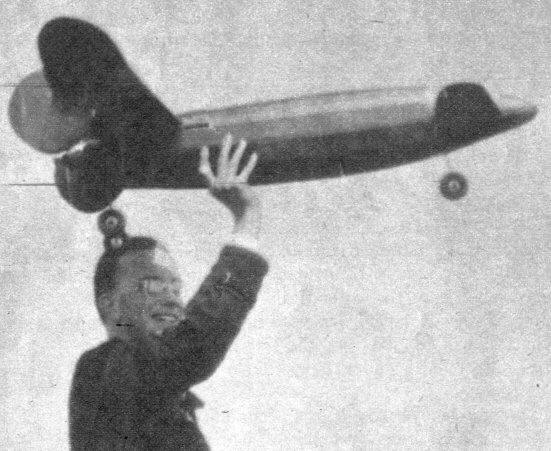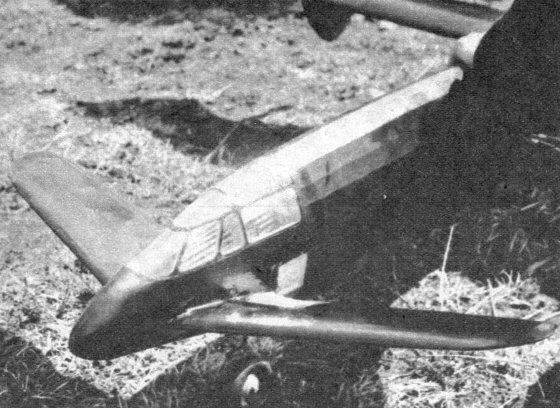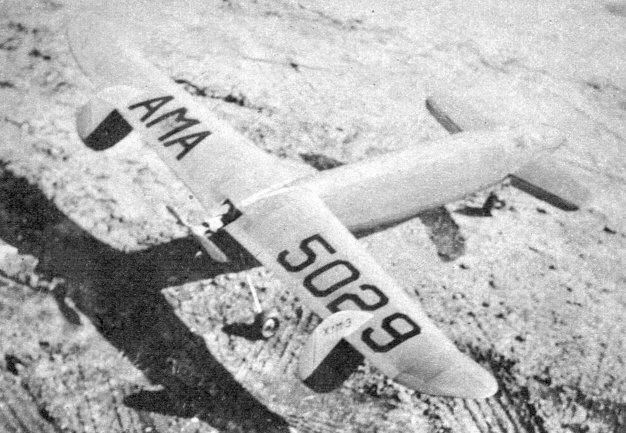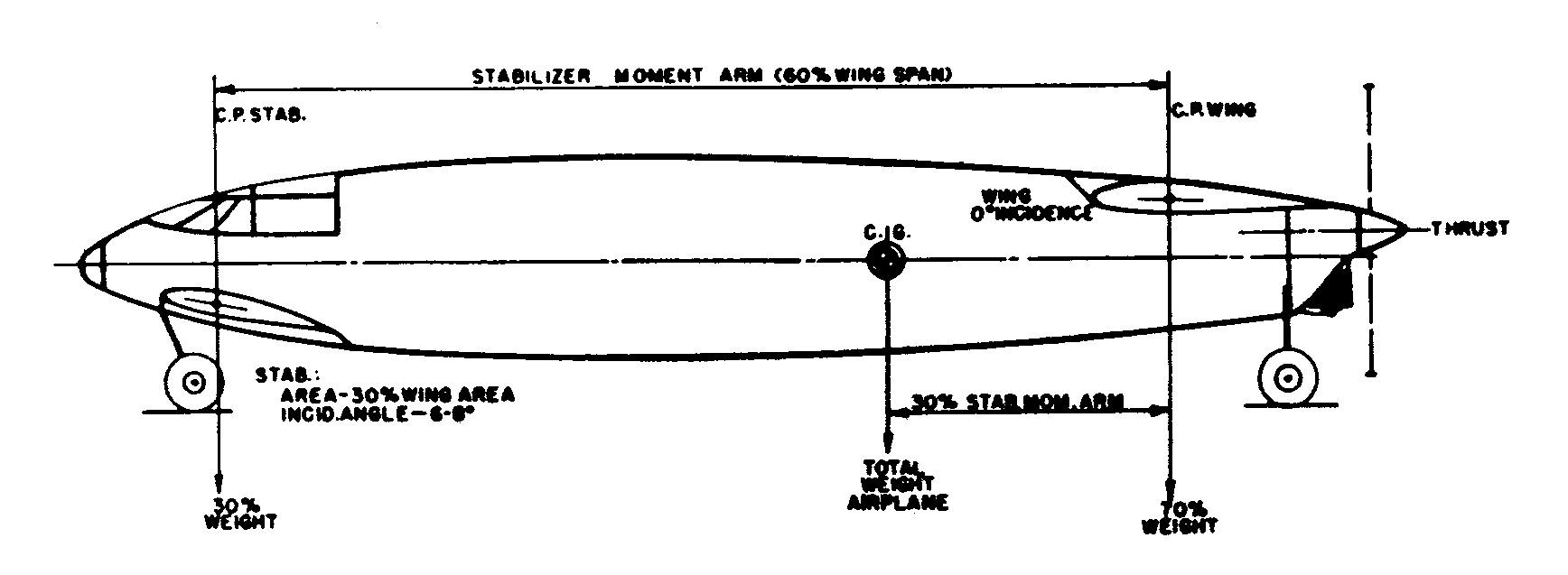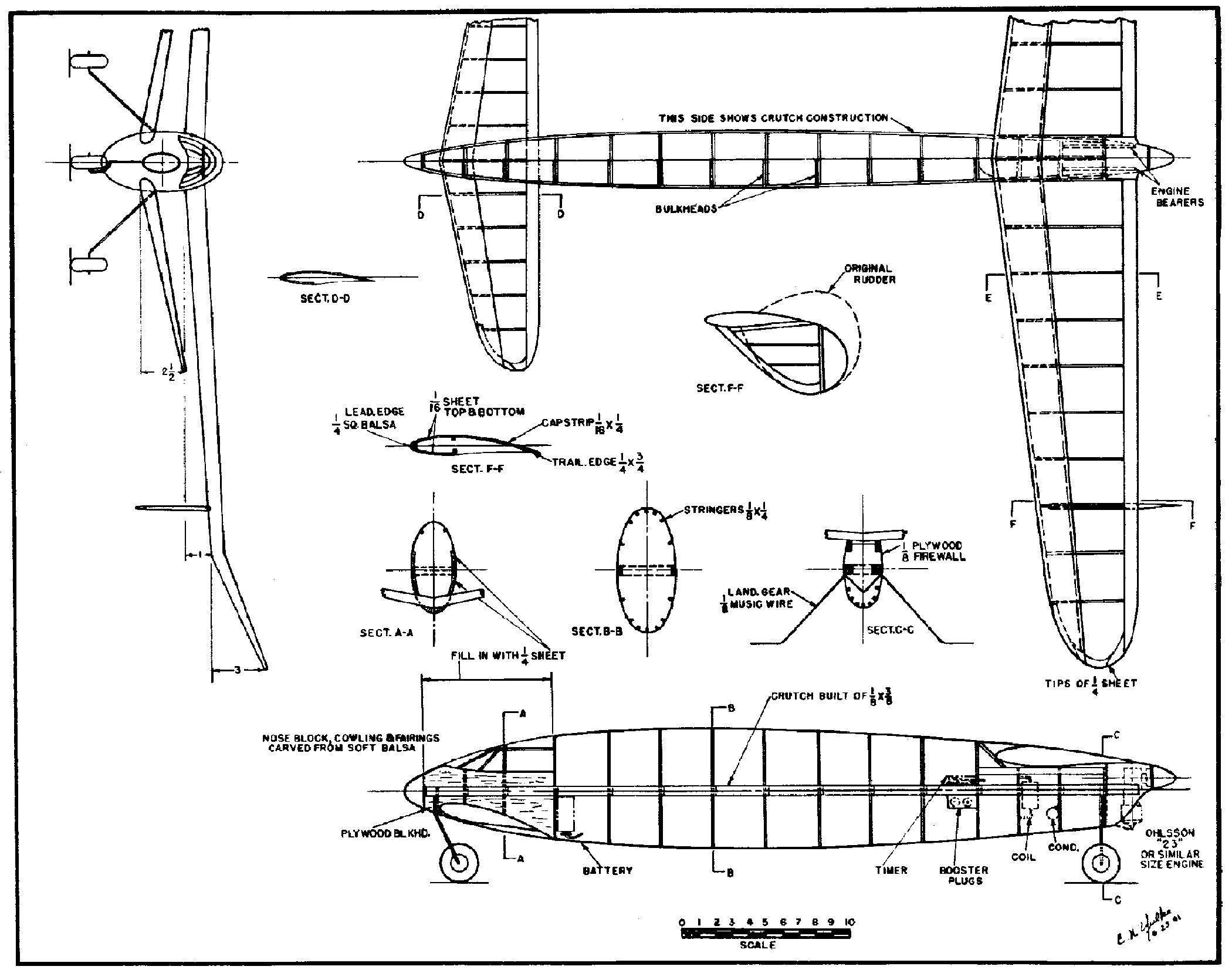|
TAIL FIRST TIPS
A model-building engineer at Republic gives the
The drawings above will give you the general idea of its
design and construction.
FROM the accompanying sketch it can be clearly seen that the model used for experiments by the author differs little in basic arrangement from the type that was prevalent in the days when Cecil Paoli and Armour Selly were setting records with models of spruce construction and powered with rubber motors cut from discarded inner tubes. The component parts of the old twin-pusher type of model were so displaced that the center of gravity was approximately one third of the ,wing-to-stabilizer moment arm, thus necessitating an incidence angle of 4 to 8 degrees in the stabilizer, while the wing remained flat on the A frame. This type of model was almost universal for a number of years, but practically disappeared with the advent of gas-powered models. From time to time pictures have appeared in various publications of canard-type models, but the technical data that accompanied these pictures indicated that each modeler had his own idea regarding the proper location of the C.G. Faced with this wide variety of opinions and performance reports, it occurred to us that with patience and a bit of tenacity, an experimental model might result in some basic data that would perhaps eliminate the basic fault of most models of this type, that is, the difference in adjustment necessary in powered flight from that of the glide. With the fact in mind that this type of model provides almost ideal antistall characteristics in that the stabilizer, being set at a higher angle of incidence than the wing, would stall before the wing would and thus reduce the amplitude of the stall and its subsequent dive to recover flying speed, a pencil was put to work. Without quite realizing what horror was being perpetrated, a rough layout of a B Class canard was appearing on the paper with a fuselage that looked somewhat akin to a fish. The moment from wing to stabilizer was about 50 percent of the 8.1 aspect ratio wing that had an area of 410 square inches and a span of 58 inches. The stabilizer area chosen for the first tests had an area of 25 percent of the wing area. These figures, although contrary to general model design practice, were chosen simply as a starting point from which to vary the stabilizer area, moment arm, and C.G. location. Thus started a period of "build it and test it" and "change it and test it" that lasted for about five months, with the usual number of "unlucky" flights. In gliding the original model, the stabilizer angle was found to be 9-1/2 degrees, which was thought to be excessive due to the drag created at that angle, and a note was made to increase the area to 30 percent of the wing area. On the first power flight with the Ohlsson "23" at about half power, the model started climbing at 45 degrees, and the author's heart climbed at 90 degrees, up as far as the wisdom teeth. The timer (on the model) cut the engine at 35 seconds, and the model seemed to float out of the climb into the glide which developed into a tendency to mush and stall slightly. This was due primarily to the C.G. being too far aft at 26 percent of the stabilizer moment arm. Thus it seemed plausible that the C.G. should be moved forward, along with the increase in stabilizer area. While these notes were being made, a dull crash was heard from the vicinity of a small tree -- and the first rework job was started. Subsequent tests were made with the C.G. at 30 percent, 35 percent and 40 percent of the stabilizer moment arm, and the stabilizer was changed to 30 percent of the wing area, and later to 33 percent. During flights testing various combinations of the above figures, best results were obtained by using a stabilizer area of 30 percent of the wing area and a C.G. location of 30 percent of the moment arm. With the C.G. forward of 30 percent, the model had a fast glide that could not be corrected without increasing the angle of incidence of the stabilizer so much that the model again had the tendency to mush. It was also noticed during these tests that the model had a tendency to be inconsistent in so far as longitudinal stability was concerned. This tendency was attributed to the short moment arm from wing to stabilizer, and it was decided to increase this to 60 percent instead of the original 50 percent. Again the model was laid on the bench for "slight revision" -- the fuselage being cut in half. The two pieces were jigged the required distance apart and structure spliced in to make the fuselage whole again. Now, the longitudinal stability leaves nothing to be desired. Rudder area on this model was a problem from the start, due to the short distance from the C.G. to the center of pressure of the rudders. The original area used was 18 percent and, since the directional stability seemed O. K., it was left as originally built until the other data was collected. The last change in the model was the reduction of rudder area from 18 percent to 10 percent, but with the entire area below the wing instead of as shown dotted in the three-view drawing. Any area above the wing, to be effective, would have to be displaced so that it resulted in high, narrow chord rudders. Throughout all the tests the gross weight of the model was kept at 30 ounces.. This was done so that a direct comparison could be made when the other items were changed. While 30 ounces may seem at first to be slightly heavy for an Ohlsson "23," actually, in its final form as shown in the balance diagram, the stabilizer was carrying 30 percent of weight or 9 ounces, while the wing supported the remaining 21 ounces. Thus it can be seen that if a canard is designed for an 8-ounce wing loading, it actually flies at less. This is permissible at the date of this writing, since the AMA regulations stipulate that a stabilizer is not considered as part of the supporting surface unless its area is more than 50 percent the main wing area. While this is a definite advantage in model competition, as soon as these models become popular again, new rulings will have to be made regarding them. Since canards are not very numerous at present, the author would like to hear from anyone building this type of model. Write in care of this magazine. Scanned From January 1942 |

